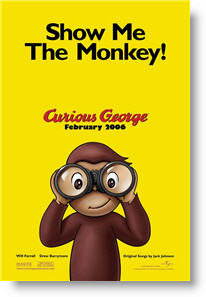Special Feature
“Curious George”—His history and the making of the 2006 motion picture
His History
Hans Augusto Reyersbach was born on September 16, 1898, in Hamburg, Germany. From a very young age, he showed an interest in both animals and drawing. Margarete Elizabeth Waldstein was born in Hamburg on May 16, 1906, and was also interested in art, eventually studying at the famous Bauhaus Institute. The two met briefly when Hans visited her father’s home and saw the young girl sliding down the banister.
After serving in World War I, Hans made a living drawing illustrations for the local circus before he moved to Brazil. There, he traveled the Amazon River and became enchanted by the troops of monkeys he found swinging from the jungle vines. While working in his family business in Rio de Janeiro selling bathtubs, he discovered that Margarete had also moved to Brazil to escape the Nazis, and they were married on August 16, 1935.
In South America, the couple shortened their names to H.A. and Margret Rey, in order to make it easier for their new countrymen to pronounce. They loved animals and briefly shared a home with two pet marmoset monkeys.
Honeymooning in Europe, the newlyweds fell in love with Paris and decided to stay there indefinitely. They set up house in a bohemian hotel in Montmartre, where H.A. worked as a newspaper cartoonist. When a publisher saw one of H.A.'s cartoons, he asked him to expand upon them-resulting in the Reys' first book, Cecily G. and the 9 Monkeys, published in 1939. H.A. came up with the ideas and the illustrations, while Margret took care of the plot and the writing. One of the book’s most interesting characters was an insatiably inquisitive monkey named Fifi who always managed to find himself in trouble. The Reys fell in love with the character and decided that their next book would focus on Fifi.
According to “Curious George” historian and author Louise Borden (The Journey that Saved Curious George),
“Some people close to the Reys have stated that Margret was a bit like George in her antics, in her zest for life. The executor of the Rey estate told me that Margret actually posed on a few occasions for Hans when he was doing his illustrations. She would put her finger in her mouth or tilt her head a certain way. Margret was a bit stocky and a bit short, and so she became George on occasion.”
Hans also drew from other characters in his life. The Man with the Yellow Hat, according to Borden, “was loosely modeled after an absent-minded professor friend that they [the Reys] knew-a man who had gone to school with Hans in Germany.”
As the Nazis advanced toward Paris in the blitzkrieg of May 1940, the couple, both German-born Jews, decided to flee to America where Margret’s sister lived. Hans quickly cobbled together two bicycles out of spare parts for their getaway, and they escaped only hours before the Nazis invaded the city. Traveling with only a few clothes, bread and cheese and five manuscripts that included their latest book, The Adventures of Fifi, they bicycled for four days-sleeping in stables across the countryside. When they reached the Spanish border, they sold the bikes for train fare to Lisbon. While on the train, the Reys were detained when an official, hearing their heavy German accents, suspected they might be spies and searched through Hans' satchel. Discovering The Adventures of Fifi, he understood they were children’s book authors and handed back their passports and visas and moved on.
From Lisbon, they found their way back to Rio de Janeiro before arriving in New York City in 1940. There, Fifi would undergo a name change when publishing giant Houghton Mifflin offered the Reys a contract-quite rare at the time-for four illustrated children’s books by H.A. In 1941, the American publishers would introduce the unsuspecting world to the mischievous monkey known as Curious George.
H.A. and Margret would go on to author and illustrate seven Curious George books, spending a year laboring over each to achieve the perfect look and tone. Many of the Reys' own interests and adventures found their way into the Curious George books. Both avid animal lovers, their first stop whenever they visited a new city was the zoo. Hans, just like The Man in the Yellow Hat, smoked a pipe. Just like George would in their books, the Reys' lived among palm trees in Brazil, rode out of Paris on bicycles and left Europe on an ocean liner.
At the core of each of the books was the same general premise upon which readers came to rely: The Man with the Yellow Hat would leave George alone in the house, warning him to be careful; not being able to help himself, George would follow his curiosity into trouble. Wild adventures would ensue.
Perhaps one key to his enduring popularity is that George appeals to the desire in all of us to break the rules (just a little) in order to satisfy our curiosity. As Margret Rey observed,
“George can do what kids can’t do. He can paint a room from the inside. He can hang from a kite in the sky. He can let the animals out of their pens on a farm. He can do all these naughty things that kids would like to do.”
For example, in Curious George Rides a Bike, he’s supposed to deliver newspapers, but instead makes boats out of all the papers, wrecks his new bike and causes pandemonium at a circus when an ostrich swallows his bugle. Ultimately, he ends up a hero after rescuing an escaped bear cub. In Curious George Goes to the Hospital, he wreaks havoc when the mayor visits, but manages to liven up things for a little girl who’s afraid at having to stay in the hospital. In fact, it was at the request of the Boston Children’s Hospital that the Reys create this book in the first place, in order to help prepare children for a hospital stay. After it was published, the Reys received hundreds of letters from parents thanking them and telling them how effective it was.
In 1989, Margret established the Curious George Foundation to fund programs for children who share the character’s curiosity for learning, exploring, ingenuity, opportunity and determination-with much consideration given to programs that benefit animal preservation, the prevention of cruelty to animals and efforts to strengthen family values and ties. Although H.A. died in 1977 and Margret in 1996, both lived to see their little monkey become one of the most beloved characters in the history of children’s literature.

It should also be duly noted that Curious George, although referred to as a monkey, is in fact, a chimpanzee. At the time the Reys were writing the books, chimps, clearly lacking the distinguishing tails of monkeys, were still referred to as monkeys by most. Even though we are careful to make that distinction today, with nostalgia and respect to the classic nature of Curious George and his creators, we still refer to him as a monkey.
About The 2005 Film Production
“Every time we diverted from the essence of those H.A. Rey illustrations, it was always frustrating, it was always a little disappointing. Ultimately, we decided that instead of reinventing it, let’s celebrate it.” -Producer Ron Howard
George first began his journey from the classic books to the screen in the early '90s, after producer Jon Shapiro stumbled across his childhood collection of Curious George books in his parent’s home.
“At Thanksgiving of that year, I was in New York visiting my family,” he remembers. “I was rummaging through my collection of children’s books when I came across Curious George. I had such a nostalgic moment, thinking to myself, 'Wow, I really have missed George and The Man with the Yellow Hat!'”
Fueled by a desire to share with others the joy this duo had brought to his boyhood, the producer found his way to the series' co-creator, Margret Rey. Widowed and almost 83 years of age, Mrs. Rey was quickly won over by Shapiro’s passion for the project. With a loving warning, she shared with Shapiro that, despite what many thought, creating George’s simple stories was quite challenging. In reality, she and H.A. had painstakingly crafted the books through numerous drafts with her modeling exhaustive poses and his finely tuned sketches.
With the rights secured, Shapiro found an equally passionate producing partner in David Kirschner, who had written and executive produced the animated classic An American Tail. Shapiro remembers what clenched the deal: “The two of us promised Margret that only the highest quality film would be pursued for the property. We knew we had to deliver an A-list project to live up to her expectations.”
Kirschner laughs, “This is one of the last great properties in the canon of children’s literature. Fortunately for us, it has had the luck of being viewed as “the prettiest girl in the class.” Everyone else thought another party had the rights to it.so it was never asked out until Jon and I came along.”
However, several years would pass before they found another like-minded Curious George fan who thought he could provide a proper home for George. Academy Award®-winning producer Ron Howard, who, early in his directing career had scored successes with such fantasy comedies as “Splash” and “Cocoon” (this was prior to his box office smash Dr. Seuss’ How The Grinch Stole Christmas), was enthusiastic about joining forces to produce the project. Producing with Kirschner and Shapiro, Howard felt a feature film adaptation of the Curious George books was a fine match for Imagine Entertainment, the production company he shared with his partner, Academy Award®-winning producer Brian Grazer.
“Initially, we considered a live-action version of the film,” offers Shapiro. “But after contacting animal trainers who told us what primates could and couldn’t do, we abandoned the idea. George had to have this embraceable quality as a soft, fuzzy, lovable monkey. We didn’t feel we could live up to the classic nature of a property already familiar to so many with a live action version of the film. While there are some very cute primates in the world, they just don’t look like George.”
The next logical stop for the production team was CGI. Computer generated imaging was coming into fashion during the late '80s and early '90s with films such as “Who Framed Roger Rabbit” and “Jurassic Park”. Names including Tom Hanks and Adam Sandler were suggested for the CGI voices behind The Man with the Yellow Hat, but still the project in development wasn’t gelling.
“At the time, photo realistic computer generated images were extremely expensive,” shares Shapiro. “Based on the nature of the books, we would have to create a 75 to 80-minute film where the majority of screen time was with a CGI George.”
CGI work also didn’t lend itself to the simplistic, primary colors and painstakingly detailed hand drawings of H.A. Rey.
With the project stalled, it would be several years before Imagine and Universal would revisit George. Producer Howard knew it was a good fit for his studio, known for making quality films, but he wanted the timing to be perfect. “Brian Grazer and I have always felt that there was just magic in that relationship,” he notes. “George’s unabiding curiosity was not only something that was really relatable for kids, parents could relate to it because that curiosity gets kids into all kinds of trouble. It [curiosity] was also something to celebrate and promote.
“There’s something adorable about young creatures,” he continues. “Human beings, monkeys, puppies, kittens-poking their head around a corner, trying to get in under a box, nudging a door until it opens and trying to see what’s on the other side.”
Howard explains, “We’ve looked at it in so many different ways-live action, 3-D animation-and we finally arrived at 2-D animation, which is a little surprising in this day and age, except it seems so utterly appropriate for “Curious George”. We’ve tried all kinds of looks-changing George, making George a completely different kind of character, just figuring out how should George look. And every time we diverted from the essence of those H.A. Rey illustrations, it was always frustrating, it was always a little disappointing. Ultimately, we decided that instead of reinventing it, let’s celebrate it and we’ll put together a narrative storyline that works well and allows us to learn more about George and certainly more about The Man with the Yellow Hat. This allows us to explore their relationship, but more than anything else, lets George get into a lot of trouble in a very entertaining way.”
“We plowed on through,” Kirschner remembers. “Between the live action, animatronic versions and the CGI, there have been several iterations of George. But our timing could not be better. So many companies have jumped on the “all-CGI cartoon” bandwagon, a lot have forgotten the art of good storytelling through traditional animation. If there’s a project that belongs in 2-D, “Curious George” is it.”
The story and design both came down to George’s basic curiosity and how to translate that into a feature-length film that kept the audience’s interest and delight. Imagine’s Academy Award®-winning producer Brian Grazer explains it succinctly: “Curiosity is a learning curve. It’s about scratching away at something that you don’t know what’s inside. And that can be jarring; it can take you off balance. It can take away your power base, but it always gets you to a better place.”
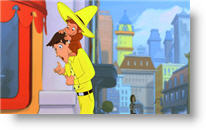
When it was decided that the film would be created in 2-D animation, once again a series of writers took turns trying to come up with a screenplay that would be faithful to the Reys' books, while compelling enough to sustain a family audience’s attention for a 75 to 80-minute running time. Unlike other feature film adaptations of classic children’s stories, it was important to the studio that this film not in any way stray from a wholesome, straightforward course when it came to tone or language. There would be no off-color humor or edginess, nothing at all to which parents of young children would worry about exposing their kids. At the same time, it needn’t talk down to its audience, nor succumb to cloying sweetness. Ultimately, it was writer Ken Kaufman who fashioned the screenplay-based on a story by Kaufman and Mike Werb-that was the sort of lively comedy-adventure worthy of “Curious George” himself.
The producers had to find a director for the project who shared their vision-while having the animation experience and the ability to pull together all the creative elements necessary to tell the story. After various false starts with other directors, the producers and studio executives agreed to let Matthew O’Callaghan take the reins. Having worked at Disney as director of Mickey’s Twice Upon a Christmas, O’Callaghan-who had also served as a supervising animator on The Little Mermaid and created television’s hilarious Life with Louie-brought fresh ideas and energy to the film that impressed the producers.
A father himself, O’Callaghan knew George needed to be accessible to both young children and adults who would be taking their children to the film. He felt it was vital to “stay true to the books in their graphic nature, with their bright colors and very appealing shapes. You have to look back on the books in the '40s. There were very simple color stylings and a lot of primary colors.”
Director O’Callaghan feels the limiting step for George’s animation was indeed his simplicity. “The choice became very obvious, because the product generates from illustrations from the book that people are very familiar with,” he notes. Traditional animation just better represents and reflects the books that had been illustrated so many years ago. The illustrations are so pure, simple and colorful. Like George, they’re so innocent. The trouble he gets into is just because he’s curious. His curiosity leads him to bigger and greater inventions, adventures that little kids could have-just using their imagination like floating balloons over the city and going on a rocket ship.”
But animation alone wouldn’t tell the story of the mischievous monkey. The director knew the value of creative writers who could weave a curious tale based on the seven Curious George books by the Reys. O’Callaghan remarks,
“In reviewing the books, we discovered many things.a lot about how we were going to ultimately style the film. The format for the books was The Man with the Yellow Hat would wake up in the morning, say goodbye to George, and George would go on his adventures and get into trouble. And at the very end, The Man with the Yellow Hat would come in and basically save the day. We quickly figured out that we had to structure the story as a buddy picture.”
Ron Howard recalls of the process, “George is so pure and so virtuous in his drive to find out how the world works. Every single meeting, every creative discussion ends with all of us smiling and nodding our heads. Whatever the problems might be, we leave just still believing in the character and the spirit of Curious George.”
A Barrel of Monkeys: Will Ferrell Leads the Cast of Voice Talent
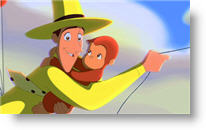
“Ted’s a blank canvas-a guy who’s lived his life in a box. Curious George teaches him to smell the roses along the way. They really help each other.”
-Will Ferrell
All throughout the long on-again, off-again development process for Curious George, one thing remained constant. Whether the film would be live action, CGI or 2-D animation, the character of Curious George would not speak. He would, however, make cute monkey noises (voiced by veteran voice actor Frank Walker) in the film. But with George not speaking, a lot of the heavy lifting as far as dialogue was concerned would have to be done by the actor voicing the role of The Man with the Yellow Hat. The actor needed to be someone with not only box-office appeal and a distinctive voice, but a flair for the comic tone of the character as depicted in the Reys' classic books.
Everyone came up with the same name: Will Ferrell.
Ferrell had shone in such comic roles as the naïf, displaced human in Elf and the wacky newscaster of Anchorman. Producer Shapiro felt Ferrell was the perfect fit.
“Will had been discussed based on his role on Saturday Night Live. His genius at character-actor personae came through in live action, so why not animation?” Ferrell jumped at the chance to be involved. “I think they had me in mind for The Man with the Yellow Hat. Which is great, because Curious George has always been a favorite story of mine,” he notes. “This is the first feature animation I’ve done, so Matt had this great combination of a steady hand directing me, while not stifling my improv. The advantage of this type of film is that you can go in any new direction, but it’s tough being an island out there-imagining and creating vocally what will happen with what you can’t see yet.”
The actor well remembers Curious George from his days in elementary school.
“Whenever the teacher brought out George in school, you thought, 'Wow, this is gonna be fun,'” he laughs. “Curious George has all the power in kids' minds. Kids love him because they feel they get to run the adventures he has.” Given the chance to voice Ted, The Man with the Yellow Hat (though never named in the books, he would need to be for the animated feature), Ferrell knew it would be a learning experience. He remarks, “Ted’s a blank canvas-a guy who’s lived his life in a box. Curious George teaches him to smell the roses along the way. They really help each other.”
Matt O’Callaghan explains,
“With Will attached to the project, we wanted to use his comic sensibilities and his style and his humor.”
And what does every bumbling explorer need to help him sort it all out? A lovely girlfriend, of course. That is exactly what Ted finds in grade-school teacher Maggie. “We actually use the name Maggie because it comes from the name Margret, the wife of H.A. Rey,” states O’Callaghan.
The team thought who better to voice the sweet, yet strong, teacher who just wants Ted to notice her than actor Drew Barrymore-fresh from the set of her latest romantic comedy Fever Pitch. With Barrymore, O’Callaghan found, “She is just fantastic. With her inflection, the way she says lines, the way she tilts her head-we were filming her as we were recording her-and the way the animators took those little nuances in her performance and put them on film; she was perfect.”
Every child’s playmate, Curious George had a special effect on Barrymore: she was overjoyed when she found out she was cast as Maggie-and by what was in store for the lovelorn schoolteacher and Ted. “I loved Curious George as a kid,” she offers. “I was so excited when I got the phone call to do this. You see, Maggie is very much smitten with Ted. And though she puts it under the guise of weekly field trips, she just has this huge, red, beating heart for him.”
Ferrell comments,
“Maggie is the impetus in showing Ted that George has been a great thing in his life, and Drew nails that part. She is not only one of my favorite actors, but she has such a great exuberance and spirit to play this character.”
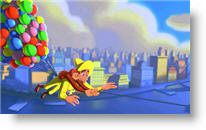
Barrymore was no stranger to voice-over work. Lauded for her voice performances in Titan A.E. and new Christmas classic Olive, The Other Reindeer, the seasoned actor admits she “tries to project the people I’m speaking for and the emotions that I think my character is feeling” to the audience. “When you’re doing voice-over work, you tend to enunciate and project your emotions and voice more. With live action, you tend to be a bit more subtle, more internal.”
For the part of Bloomsberry, the senior curator, O’Callaghan had no problem figuring out who should take the role: Dick Van Dyke. “When we started creating the character, Dick just jumped in my head as this legendary actor, someone who has wonderful charisma and appeal-a terrific voice and passion for animation and family entertainment. We needed an actor in the range of the character who could act feeble, but could also have tremendous energy.”
Van Dyke was happy to oblige. The actor has been a family favorite since his days as the unforgettable chimney sweep of Mary Poppins.
“I love any kind of animation,” he comments. “This film reminds me of the classic animated movies, and I’m just glad that real animation is still alive. You can’t match the emotion of it.”
The producers and director topped off the all-star cast with a few surprises. David Cross would be cast to voice the devious Bloomsberry, Jr. With his acerbic wit and sharp timing, Cross knew he could bring life to Ted’s nemesis at the museum. Eugene Levy shares his unmistakable voice for the wacky inventor Clovis, who helps Ted and George get out of the stickiest situations. Finally, British actor Joan Plowright would agree to voice the dotty diva, Miss Plushbottom, who finds herself the unsuspecting subject of George’s art project when he “redecorates” her penthouse.
The hard work was worth it. All the actors involved remained curious about one thing: how would their animated selves be represented on screen? Voice acting to a script is one thing, but they all express excitement about seeing the finished project. Ferrell sums up their enthusiasm: “Curiosity is that built-in mechanism we have for learning how we are going to exist. Without it, we stop growing. It fuels our lives.”
Animators Work Their Magic: Designing “Curious George”
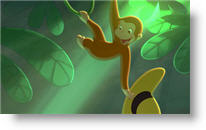
“It’s an animator’s dream to create a character in pantomime where you don’t have the aid of dialogue. but solely your pencil and expressions to carry the feel of the scene.”
-Director Matthew O’Callaghan
Having decided on traditional 2-D animation for “Curious George,” now came the question of who would create the animation. Universal has only been sporadically involved in animated films over the years, the last being 1995’s Balto, but the studio has never had an in-house animation unit. Other studios that were known for their animated projects had abandoned traditional animation in favor of CGI and dismantled their in-house animation teams. With few 2-D animated films being produced, there was a surplus of unemployed animators eager for the opportunity to practice their craft. The studio put together an ad hoc animation team for the film, made up of some of the very best freelance animators in the business.
With the key production players in place, it was time to animate the monkey for movie lovers across the world. It would assuredly be dictated by the beautiful artwork and spirit of H.A. and Margret’s work, and Ron Howard knew they couldn’t go wrong with this plan. Howard lauds,
“The degree of passion and care coming from the art department in support of this movie is really like nothing I’ve ever seen before. There is so much passion and focus put into getting the color pallet just right-expanding it just enough to make it work for a movie audience-but never veering too much from that wonderful feeling that you get from looking at a Curious George book.”
Kirschner agrees.
“I feel like the artwork of the film has fallen off the pages of a Curious George book. Any animator knows it is unbelievably tough to capture the images with simple lines and keep the story compelling. It looks so simple, but to keep that line work consistent for 80 minutes is impossibly tasking. All of us set out to create a world inspired by the Reys' invention. I feel we have gone far beyond its original scope with this film.”
“A lot of George’s personality was conveyed through gesture in the illustrations,” shares Rey historian Borden. “And the children reading Curious George sometimes can’t read words yet. But they can look at those illustrations and understand how George is feeling-his happiness and curiosity-through his facial expressions.”
Referring to the nonverbal George, director O’Callaghan adds,
“It’s an animator’s dream to create a character in pantomime where you don’t have the aid of dialogue.but solely your pencil and expressions to carry the feel of the scene.”
O’Callaghan recalls, “At the same time we nailed our script down, we developed the style of the film-what the film is going to look like-using the books for a guide or reference point on how to style buildings and color.”
The director’s right hand, production designer Yarrow Cheney, would re-create this rich and beautiful world with the Rey style guide of primary colors as his pallet. Cheney refused to even use purple, as that color was never introduced in the Reys' series. The storyboard department would tell the story by Kaufman and Werb frame by frame in single images, drawn in black and white by animators. The layout department would next design the close-ups and the wide shots and backgrounds behind the characters. Then the background department would take these drawings and paint the beautiful colors, shadows, water, etc.
O’Callaghan notes of the process,
“We illustrate the film in single images, since we have to draw every frame. We’re very selective about what we draw as a close-up, what we draw as a wide shot. All of that is mapped out ahead of time before work is done.”
This happens while a parallel team works simultaneously on each character of the film.to ultimately place on top of the created backgrounds.
Only a few animators worked on each of the characters, from George to Ted, Maggie and the supporting cast. This specialization allowed mannerisms and affectations of the characters to remain consistent. O’Callaghan notes, “We funnel these drawings through our clean-up department to make sure that Ted always looks like Ted and George always look like George.” Little by little, the black-and-white movie turns into a color film with sound carefully laid on top of the animation.
Barrymore was particularly thrilled to see her beloved George drawn so lovingly by the animators.
“Because of my love for Curious George and the immense following that it has, I feel like it’s a really wonderful honor to this story and the art of it that we all loved for the past 60 years, they’re keeping this film in a 2-D format,” the actor notes. “In the technological world we live in, we don’t have that sort of warm, old-school feeling a lot, and so it’s just a real treasure when it does happen.”
The Music of Jack Johnson
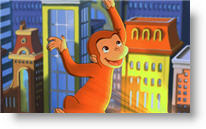
“I like to think I’m the monkey himself. I’m his voice, in a way, since he can’t speak. I’m writing songs that explain what’s in his head.”
-Jack Johnson
With a monkey who could only chatter, the filmmakers quickly realized that the audience needed to hear the soundtrack in George’s head. What a find it was for the production team to realize that celebrated recording artist Jack Johnson was also a huge Curious George fan. Much like George, they knew Johnson has a rare appeal to children, teens and adults alike.
Johnson, a multi-platinum artist, realized behaving like a monkey wasn’t out of his repertoire when he was asked to come on board. “I like to think I’m the monkey himself. I’m his voice, in a way, since he can’t speak. I’m writing songs that explain what’s in his head.”
Director O’Callaghan shares, “Because George doesn’t speak, he just makes his little monkey sounds and expressions, we need him to be curious and expressive. The Jack Johnson song that we introduce George with is called “Upside Down” [the first single to be released from the film’s soundtrack]. It’s very energetic, and Jack is a terrific artist. He really brings the soul of George out onto the screen. He has the ability to lay music that sucks you into that feel; it doesn’t overwhelm George, but it taps into his character in a perfect way.”
Universal Pictures' president of film music, Kathy Nelson, offers validation for the selection of Johnson. “As luck would have it, Jack just had a baby, and he adores Curious George,” she notes. “So it was sort of a freaky coincidence, but he completely embraced the idea of it.” Just like with Curious George, “If you go to a Jack Johnson concert you’ll see everybody ranging from every age-the parents, the teenagers, the kids, the infants.”
Johnson would watch the scenes from the movie pre-paint to get inspiration for the songs he wrote for the film and its album, “Jack Johnson and Friends: Sing-A-Longs and Lullabies for the Film ‘Curious George’.” He thinks, “George is basically like a kid in his terrible twos-he doesn’t have bad intentions, he just gets himself into a lot of trouble by being curious.”
With a son of his own who just turned two, Johnson can relate to George’s need to touch and feel his universe. “I’ll show my kid one thing one day, then I’ll see him doing it by himself in the corner the next day.” The musician feels, “There couldn’t be a more perfect time than when you’re just sitting around playing songs for your kid. Even though George is in a little monkey body, there’s really no difference between him and a little kid. I think the neat opportunity in this movie is to try and sing songs that kids will get something out of.and somehow hopefully grow into better people because of them.”

See our review page: “Curious George”.
